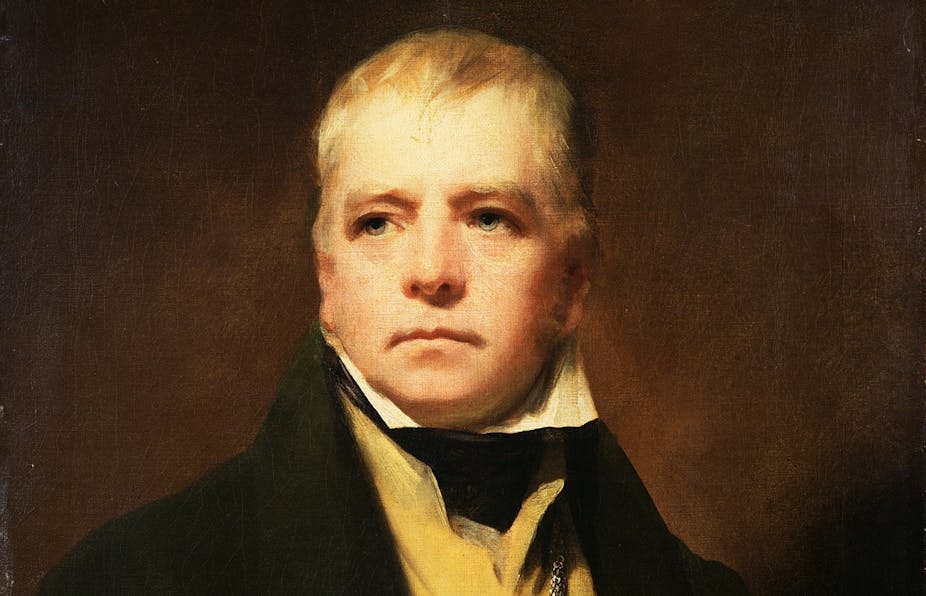This week sees the 200-year anniversary of the publication of Walter Scott’s first novel Waverley. Journalist Stuart Kelly has called Scott “the man who invented a nation” but what is Scott’s relevance for today? What kind of version of Scotland and of history more generally has he given us?
Scott has suffered from bad press. Often seen as the man who gave the world a tartan and shortbread image of Scotland, some accuse him of creating a version of the country that is no more than a museum piece, valuable for the tourist industry, but of little relevance for the re-negotiation of a modern Scottish identity. Other critics have suggested that while he created a beautiful and romantic version of the Highlands he simultaneously contributed to the writing out of Gaelic and Celtic culture from the narrative of a progressive Scottish nation.
Yet interest in Scott persists. More than 100,000 copies of his novels have been sold in the Edinburgh edition of the Waverley novels alone. His home in the borders, Abbotsford, has undergone a multi-million pound refurbishment and was reopened to the public by the queen last year. Work on Scott by critics such as Ian Duncan, Penny Fielding, Catherine Jones, Andrew Lincoln and Caroline McCracken-Flesher has also urged a re-thinking of our views of Scott, suggesting that he still has much to offer readers today.

Scott was perhaps a victim of his own success. His novels sold in unprecedented numbers; Waverley sold more than all other novels published in 1814 put together. By the time he published Rob Roy in 1818, 10,000 copies were sold in less than two weeks – a huge achievement for the time, which went on to make Scott the first international bestseller. For many years, his novels were among the most widely read in Europe.
This success also spawned a wave of Waverley adaptations, stage plays, operas, cheap chapbook editions and later, children’s versions. While these did much to publicise Scott, they nearly always stripped out the complexity of his original work. They negated the darker questions that Waverley raises, at times reducing it to farce and comedy.
Similarly Scott caught the imagination of illustrative artists. At its best the art work produced for example by JMW Turner captured the subtle relationships between place, memory and imagination at play in his work. At its worst, illustration reduced Scott to a set of romantic clichés.

To take one example, in a famous scene from Waverley Flora MacIvor, sister of a Jacobite highland chief, seduces Waverley to the Jacobite cause by singing to him by a waterfall. In the novel the scene is highly staged and highly ironic and a careful reader will note that if they too are seduced by the romantic image offered here, they are as foolish as the rather hapless hero Waverley. But later illustrations of this scene, particularly in children’s editions, have none of Scott’s irony. The episode inevitably becomes simply an iconic romantic highland image.
By the end of the 19th century, Scott was near compulsory reading in schools and in many ways his fall from favour was secure. Reconstructed as an author purveying sound values for children in the age of empire, Scott seemed to offer little to the modernists of the early 20th century.
Yet he persists, and ever since the Marxist critic Georg Lukacs drew attention to him in the 1930s as offering the archetypal form of the historical novel, his star has gradually been once again on the rise. While Lukacs’ view that Scott is always on the side of progress and modernity now seems rather simplistic, he is right in recognising that Scott is investigating the ways in which our collective histories impinge upon our current experiences and how we must find a way to acknowledge their legacies without becoming burdened by the weight of them.
In Waverley, for example, Scott describes and even affirms the Hanoverian defeat of Jacobitism. But he also acknowledges the high price that must be paid for such a movement towards modernity. Perhaps more significantly, he reminds us that progress cannot be divorced from our emotional attachment to the past, and that this must be taken into account when negotiating our relationship to it.
Elsewhere Scott also addresses a question particularly pertinent for our own times, political and religious fanaticism. In novels like The Tale of Old Mortality and The Bride of Lammermoor, he explores the tragic consequences of dogmatic adherence to such a cause. Both novels offer a bleak vision of the inevitable outcome of such extremist beliefs, and undermine any notion that Scott always offers us resolution. Instead they suggest that when extremism persists, history can give us no winning side but only tragedy.

Throughout his work Scott is fascinated by the relationship of the past to the present and the ways in which we can simultaneously commemorate history without being trapped by it. His novels offer a wealth of questions about how national identities are shaped, how political frameworks emerge and re-emerge, and how moments of conflict resonate in our collective memories. But they seldom offer us any solutions.
As a consequence his novels are perhaps best seen not as museum pieces but rather, as acts of on-going commemoration, texts which call the past back to our minds to be re-examined without seeking to enshrine it. In this year of historical anniversaries like the battle of Bannockburn and the World War I, it is particularly worth returning to Scott. Not because he will offer us any definitive answers but because his work asks the most pressing questions about how we may both remember our history and find a way of dealing with it.

